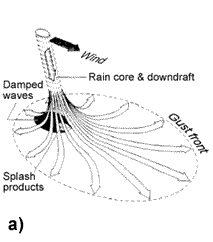
Natural Resources Canada > Earth Sciences Sector > Priorities > Canada Centre for Remote Sensing
Oceans
SAR images can be used to detect and monitor a range of physical processes and phenomena, both natural and man-made that modulate the ocean surface roughness. Surface winds are the most important factor affecting ocean surface roughness. Rough surfaces typically have higher backscatter compared to smoother surfaces. The ocean surface roughness can be related to a number of atmospheric phenomena such as convective cells, atmospheric fronts, rain cells (Figure 9-49) and atmospheric gravity waves to name a few; and oceanic phenomena associated with currents, e.g., oceanic eddies, internal waves, water mass boundaries, and surface gravity waves. Other ocean surface features are related to either biogenic and/or anthropogenic ocean surface films, which damp small scale surface waves leading to a lower backscatter than that from surrounding areas.
 
Figure 9-49. a) Schematic sketch of the downdraft of a rain cell, spreading over the sea and causing roughening of the sea surface  , b) Rain cells imaged by ERS-1, showing gust fronts (high backscatter) and areas where bragg waves are damped (low backscatter) by the ocean surface layer turbulence generated by heavy rainfall, (Source : http://www.ifm.uni-hamburg.de/ers-sar/). , b) Rain cells imaged by ERS-1, showing gust fronts (high backscatter) and areas where bragg waves are damped (low backscatter) by the ocean surface layer turbulence generated by heavy rainfall, (Source : http://www.ifm.uni-hamburg.de/ers-sar/).
The following sections will illustrate how multi-polarization and polarimetric SAR data and analyses can help with ocean applications including:
| 